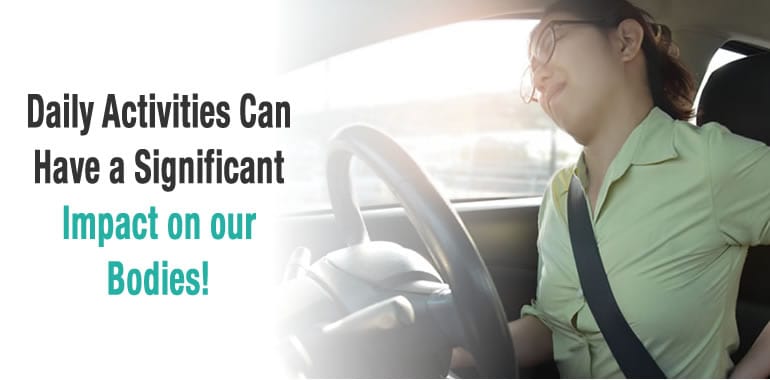
It’s no secret in the physical therapy world that daily activities can have a significant impact on our bodies, some being positive and others being devastating. After a long period of staying at home and living a more sedentary lifestyle than usual, our bodies may be quietly crying out for help. Maybe there’s new back pain from watching too many Netflix shows on the couch or maybe you have tech neck from working at home all day. Either way, these abrupt lifestyle changes that have occurred over the past year will undoubtedly have an affect on our bodies.
As schools, work offices, and places of business open up, we are collectively heading back into our old routines. That may mean long drives home from work as we are back to the usual traffic of the pre-pandemic world. Or maybe you have a long flight across the world. Regardless, it’s important that any pain or injury that has manifested during the pandemic is treated. Then, we need to make sure that we are jumping back into our routines with the specific tools to make sure that we protect ourselves from injury and poor posture that can lead to chronic pain. This presents a problem for physical therapists in an unusual way. We need to help patients treat any problems that have occurred over the past year and a half, while also preparing for new issues to pop up as we see people heading back into their normal life. This is where health education comes in. As the saying goes, knowledge is power. And in this case, knowledge could mean less trips to the physical therapy office!
Although working from home may be fading away, as clearly seen by the rush hour traffic that seems to be back for good, working from home may become permanent in some sectors. This means that back support and proper posture are essential for protecting your back and living pain-free. Even if you’re back in the office, you will probably be sitting at a desk for most of the day. First things first, make sure that you are creating periods of time in your work schedule where you can get up and walk around. Being sedentary throughout the day isn’t good for your musculoskeletal system, but it can also have dramatic effects on our cardiovascular system and mental health. Sitting for prolonged periods can put a lot of pressure on both your spinal discs and back muscles, leading to increased tightness and chronic pain. Additionally, sitting with poor posture can have even more devastating effects on the body. Slouching forward can cause the spinal discs to be put under too much pressure. Over time, the increased pressure on the spinal discs can cause strained or sprained spine as well as herniated discs. This can sound scary, but no need to worry. Poor posture can be corrected through learning about proper techniques.
First, make sure that you are sitting upright and not leaning forward, as this increases disc pressure. It is best to sit slightly back, at around a 100 degree angle. This posture allows the spine to sit in its neutral, S-shape position. As you lean forward the pressure on your spinal discs increases. Additionally, you can get an ergonomic desk chair or a lumbar support cushion to aid in posture. When sitting you also want to make sure that your computer screen is at eye-level. Your head has a significant amount of weight (as much as a bowling ball!), and when you are looking down towards a screen, you are putting too much stress on both the cervical and thoracic spine. Additionally, you want to make sure that you are not bringing your neck forward to see the screen. Make sure that you are sitting with your ears and shoulders aligned. These small changes in posture can have a significant impact on your body and will help you to avoid chronic pain.
These same techniques should be used whenever you are sitting for a prolonged amount of time. Whether you’re sitting in traffic or on a long flight, these techniques can help to make sure that you don’t pick up any new pain or stress on your back. It is crucial that your posture is maintained regardless of the activity, as spinal stress over a long period of time can lead to chronic pain.
Making small changes to your everyday activities can have huge impacts on your health. Through the daily craziness that life brings, we can become unaware of how much our routines can impact our health. Next time you sit down at your desk or get ready for a long road trip think about the techniques you can use to avoid chronic pain and injury. These changes will have a profound impact on your ability to continue doing the things that you love!
- A Return to Old Routines: How to Sit - September 23, 2021
- All About Our Free Discovery Session - September 16, 2021
- A Guide to Physical Therapy Recovery - June 8, 2021





